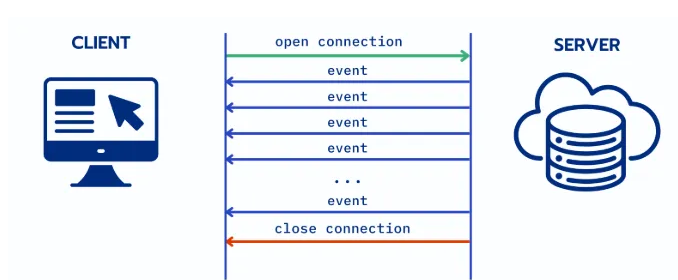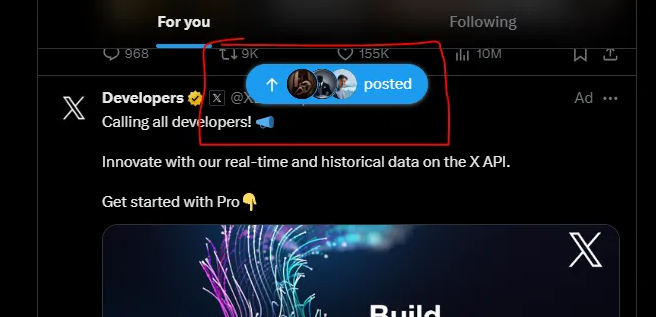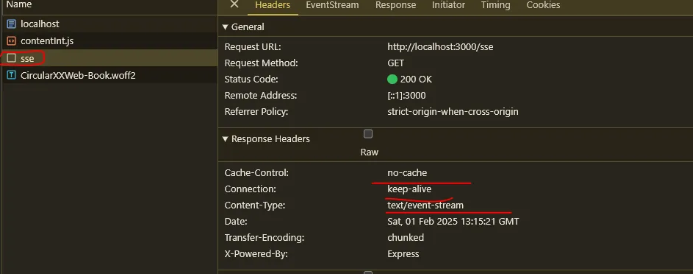Server Sent Events: A Real time communication

Let’s talk about a modern way of real-time communication on the web: Server-Sent Events (SSE). It’s supported by most modern browsers. So, let’s understand what this is.
First, a connection is made from the client, which is basically an HTTP connection. This connection is long-lived. Whenever new data is available on the server, it is sent to the client at regular intervals.

But there are a few key terms we need to understand:
- Long-lived connection
- Unidirectional connection
- Single HTTP connection
For example, on platforms like LinkedIn or Twitter (X), you see notifications like "New post available" without refreshing the page. Similarly, in monitoring dashboards or notification systems, the client doesn’t have to do anything—the server pushes the updates automatically.

So now you might be thinking, how does this work? How does the data come through, and do we need any third-party libraries? 🤔
Let’s discuss these things. We receive data in the form of event streams.
🚀 How to Achieve This?
Generally, on the server side, we expose an endpoint where we send data as a stream with the content type text/event-stream.
On the frontend, we make an HTTP API call and use the EventSource API, which is natively supported by modern browsers. This allows us to listen for events sent by the server.
For now, on the server, we’ve mimicked the process by sending data as an event stream every 5 seconds.
📂 GitHub Repository
I’ve added a GitHub repo where you can clone the project, follow the commands, and see it in your browser. But if you really want to understand how it works—whether you run the code or not—I’ve provided the core code below.
git clone https://github.com/ashumsd7/web-communication-techniques.git
cd web-communication-techniques
npm i
npm run server-side-events
-------------------
Open browser and type
http://localhost:3000/ // Observe network tab
💻 Server Code
Here’s the server’s core logic:
app.get('/sse', (req, res) => {
// data is going to be long live
// data is going to be as event stream and no cache
res.setHeader('Content-Type','text/event-stream')
res.setHeader('Connection', 'keep-alive')
res.setHeader('Cache-Control', 'no-cache')
// logic of data is going to be here : Database call
res.write('data: Hello, client! This is a test message.\n\n');
// after 5 seconds it will send random number
const intervalId = setInterval(() => {
res.write(`data: Random number: ${Math.floor(Math.random() * 100)}\n\n`);
}, 5000);
req.on('close', () => {
console.log('Client disconnected');
clearInterval(intervalId);
res.end();
});
});
So if you see above, we have an endpoint that will be called by the client. We are setting headers to:
- Keep the connection alive for a long-lived connection.
- Set the Content-Type as
text/event-stream. - Disable caching with no-cache.
Then, we are writing the stream, and after 5 seconds, we write again. So, any client that is listening to this will receive the data.
In between, you can add database logic or any other operations. This is just mimicking the functionality of Server-Sent Events (SSE).
Now, let’s look at the frontend code.
💻 Frontend Code
Here’s a snapshot of the frontend code where we use EventSource and wait for the data.
const eventSource = new EventSource('/sse');
// Listen for messages
eventSource.onmessage = function(event) {
console.log('Event received:', event.data);
};
So, it’s super easy! We are just listening to the event and logging it to the console.
Now, you can also display it on the DOM of your web page.
🔍 Let's Inspect It
After running the server, open localhost:3000 in your web browser.
You will see the incoming data in the console and, if implemented, on the webpage as well.

A long-lived and no-cache request is being made. Right after that, you can see a tab labeled "Event Stream", just like we had the "Messages" tab in WebSocket.
If you want to explore more about WebSocket, check out this blog:
Here’s a screenshot showing what it looks like when we switch to the Event Stream tab:

Now, if you look at the UI, you’ll see that the data is getting populated in real-time! 🚀
This happens seamlessly as the server pushes new events to the client without any need for manual refreshes. Pretty cool, right?

Challenges
- Browser compatibility
- Number of connections (6-8 per domain)
- Reconnection logic
- Background tab behavior
- Resource utilization
- Sticky connections
- Proxies and firewalls
- Testing and load balancing
- Efficient broadcasting
So, that’s all for this one! More topics will be discussed in upcoming blogs, including Webhooks. Stay tuned! 👋 Bye bye!
